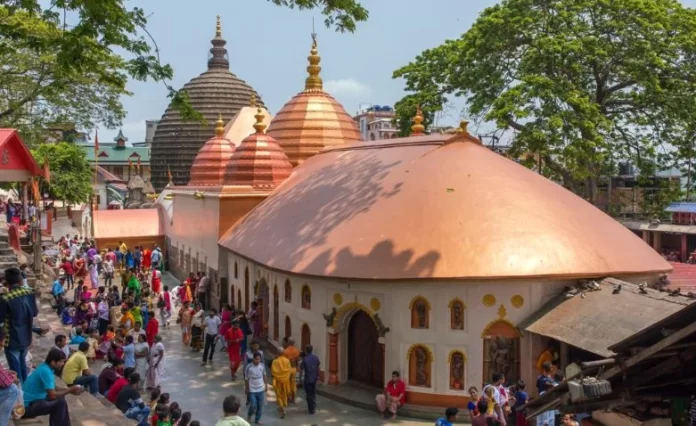The Kamakhya Temple is one of the oldest Shakti Peeth (shrines dedicated to the divine feminine) in the country. Here are 21 Facts About Kamakhya Temple.
The Kamakhya Temple, also known as Kamrup Kamakhya, is a significant Hindu temple dedicated to the goddess Kamakhya, located atop the Nilachal Hill in Guwahati, Assam, India.
Kamakhya Temple holds great religious and cultural significance and is a popular pilgrimage destination, particularly for devotees of the Shakti sect. The temple complex includes several other smaller temples dedicated to different forms of the goddess, along with various rituals and ceremonies performed throughout the year.
Facts About Kamakhya Temple
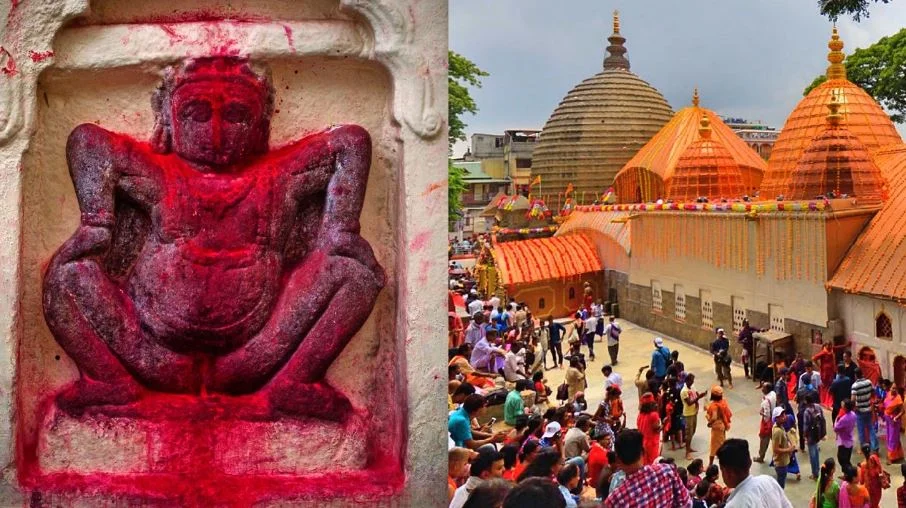
Here are 21 interesting Facts about Kamakhya Temple.
1. History of Kamakhya Temple (A Sacred Shakti Peetha)
Kamakhya Temple is a revered Hindu temple located in Guwahati, Assam, India.
It is one of the 51 Shakti Peethas, where the body parts of Goddess Sati, the consort of Lord Shiva, are believed to have fallen.
The temple is dedicated to Goddess Kamakhya, who is worshipped as the embodiment of feminine power and fertility.
- Kamakhya Temple holds great significance among Shakti worshippers and devotees of Goddess Kamakhya.
- The temple is believed to have been originally built in the 8th century, although the current structure dates back to the 17th century.
- It is renowned for its distinctive architectural style and intricate sculptures. The main deity of the temple is Devi Kamakhya, an embodiment of the goddess Shakti.
- It attracts pilgrims from all over the world seeking blessings and spiritual fulfillment.
2. Unique Menstrual Mystique
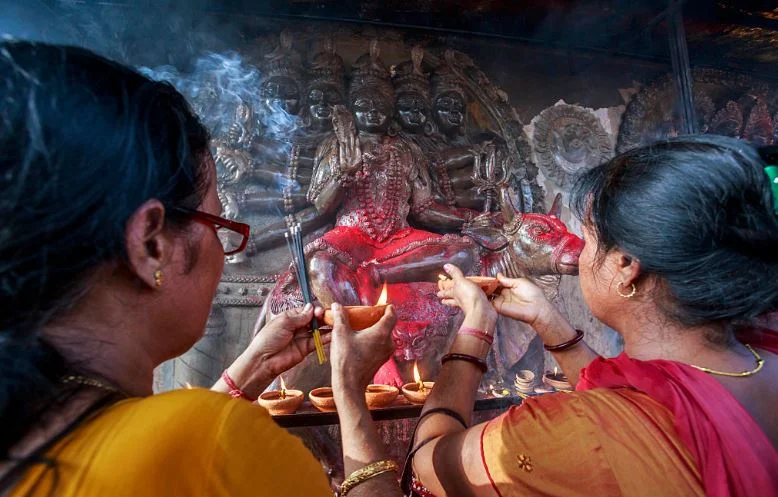
Kamakhya Temple is renowned for the unique celebration of the Ambubachi Mela, which honors the menstruation cycle of the goddess.
During this festival, the temple remains closed for three days as it is believed that the goddess undergoes her annual menstrual cycle.
The temple reopens on the fourth day with great festivities and devotees gather to seek the divine blessings.
The Ambubachi Mela showcases the acceptance and celebration of womanhood and the power of fertility.
It is a distinctive aspect of Kamakhya Temple that sets it apart from other Hindu temples.
3. Architectural Facts About Kamakhya Temple
The Kamakhya Temple exhibits a unique blend of architectural styles, combining elements of both Hindu and Islamic design.
The temple’s dome-shaped structure, known as a shikhara, is a prominent feature of its architecture.
Intricate carvings and sculptures adorn the temple walls, depicting various gods, goddesses, and mythological figures.
The temple complex encompasses multiple smaller shrines dedicated to different deities, adding to its architectural grandeur.
The Kamakhya Temple’s distinctive architecture is a testament to the rich cultural heritage of the region.
4. Tantric Practices Facts about Kamakhya Temple
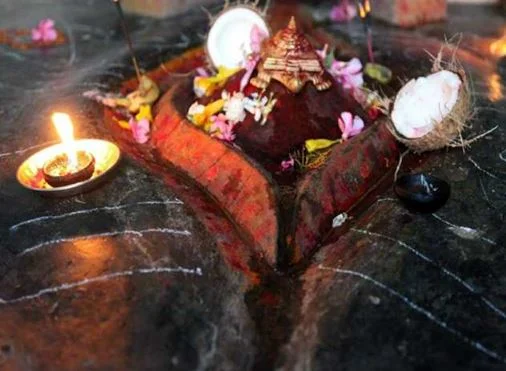
Kamakhya Temple is closely associated with Tantric practices and rituals.
Tantric devotees and practitioners consider the temple as a center for tantric worship and spiritual practices.
The rituals conducted at the temple are said to harness the divine feminine energy and invoke spiritual transformation.
Tantric scriptures and rituals emphasize the union of the masculine and feminine aspects of divinity.
Devotees seeking spiritual empowerment and enlightenment often engage in tantric practices at Kamakhya Temple.
5. Bleeding Goddess
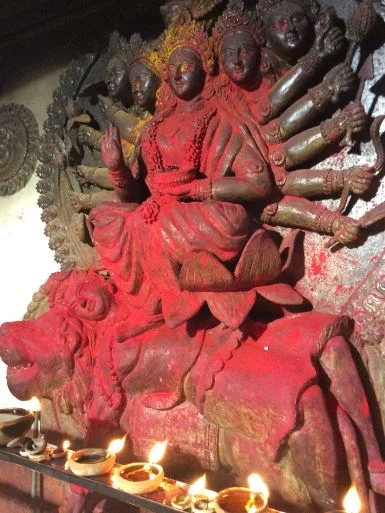
According to Hindu mythology, Kamakhya Temple is closely linked to the legend of Goddess Sati.
It is believed that when Lord Shiva was performing the Tandava (cosmic dance) carrying Sati’s lifeless body, her yoni (female genitalia) fell at the spot where the temple stands today.
The Kamakhya Temple is thus considered a symbol of feminine power and the eternal cycle of creation and destruction.
The presence of a naturally occurring spring within the temple complex, which turns red during the Ambubachi Mela, is associated with the goddess’s menstrual cycle.
This unique legend adds to the mystique and spiritual significance of the temple.
6. Five Main Temples within the Kamakhya Complex
The Kamakhya Temple complex comprises five main temples, each dedicated to different forms of the goddess.
These temples are Kamakhya Devi Temple, Bhubaneswari Temple, Bagalamukhi Temple, Tara Temple, and Chinnamasta Temple.
Each temple represents a different aspect of the goddess and attracts devotees seeking blessings and fulfillment in specific areas of life.
The presence of multiple temples within the complex offers a comprehensive spiritual experience to the devotees.
Pilgrims often visit each of these temples to pay their respects and seek blessings from the respective forms of the goddess.
7. Kamakhya as a Fertility Goddess

Goddess Kamakhya is primarily worshipped as a fertility goddess, and the temple is associated with prayers for progeny and childbearing.
Couples seeking fertility blessings often visit Kamakhya Temple to seek the goddess’s grace and blessings for successful conception and childbirth.
The temple is considered particularly auspicious for childless couples, and it is believed that the goddess fulfills their desires for parenthood.
Special rituals and offerings are performed at the temple to invoke the goddess’s blessings for fertility and the well-being of children.
The worship of Kamakhya as a fertility goddess reflects the significance of motherhood and the continuity of life.
8. Where is Kamakhya Temple Located?
The temple’s location atop the Nilachal Hill provides panoramic views of Guwahati and the Brahmaputra River. It is surrounded by lush greenery, creating a serene and spiritual atmosphere for devotees and visitors.
- Guwahati, the largest city in Assam, is well-connected by road, rail, and air, making it easily accessible for pilgrims and tourists.
- The Kamakhya Temple is located approximately 7 kilometers from the Guwahati city center.
9. Assamese Culture
Kamakhya Temple holds immense cultural and religious significance in Assam, the northeastern state of India.
The temple is regarded as one of the most important landmarks and spiritual centers of the region.
It is deeply woven into the fabric of Assamese traditions, festivals, and religious practices.
The annual Ambubachi Mela and other festivities associated with the temple attract a significant number of devotees and tourists to Assam.
Kamakhya Temple plays a vital role in preserving and promoting the rich cultural heritage of Assam.
10. Neelachal Hill and Scenic Surroundings
Kamakhya Temple is situated on Nilachal Hill, providing a picturesque setting for the temple complex.
The hill offers panoramic views of the Brahmaputra River and the surrounding lush greenery.
Visitors can enjoy the serene and tranquil ambiance while exploring the temple and its surroundings.
The temple’s location on the hilltop adds to its spiritual aura and provides a serene atmosphere for devotees to connect with the divine.
The scenic beauty of Neelachal Hill complements the spiritual experience of visiting Kamakhya Temple.
11. Festivals Facts about Kamakhya Temple
Kamakhya Temple celebrates several festivals throughout the year, attracting devotees from far and wide.
The Ambubachi Mela, as mentioned earlier, is the most significant festival associated with the temple.
Other major festivals include Durga Puja, Navaratri, Manasa Puja, and Diwali, which are celebrated with great enthusiasm.
These festivals witness elaborate rituals, devotional music, dance performances, and cultural programs within the temple complex.
The festive atmosphere during these celebrations adds vibrancy to the spiritual experience for devotees.
12. Mythological Facts about Kamakhya Temple
The Kamakhya Temple is deeply rooted in Assamese mythology and folklore.
According to Assamese legends, the temple is associated with the Kamrup Kingdom and its ruler, King Narakasura.
It is believed that the temple was originally established by King Narakasura, who worshipped Goddess Kamakhya.
The temple’s rich mythology and folklore contribute to its historical and cultural significance among the local community.
Stories and legends associated with the temple are passed down through generations, adding to its mystique and allure.
13. Spiritual Facts about Kamakhya Temple
The Kamakhya Temple offers various spiritual practices and rituals for devotees to connect with the divine.
Visitors can participate in traditional puja ceremonies, where priests perform rituals on their behalf.
The temple also offers special rituals and ceremonies for individuals seeking specific blessings or remedies.
Devotees can offer prayers, flowers, and other offerings at the temple to express their devotion and seek the goddess’s grace.
The spiritual practices and rituals at Kamakhya Temple provide a sacred space for devotees to deepen their spiritual connection.
14. Preservation of Kamakhya Temple
The Kamakhya Temple is a protected monument under the Archaeological Survey of India (ASI).
The ASI plays a crucial role in preserving the temple’s architectural heritage and historical significance.
Conservation efforts are undertaken to maintain the temple’s structural integrity and prevent any damage or decay.
Regular maintenance and restoration work is carried out to ensure the temple’s longevity and preservation for future generations.
The preservation of Kamakhya Temple safeguards its cultural and religious heritage for devotees and visitors.
15. Pilgrimage Destination and Tourism
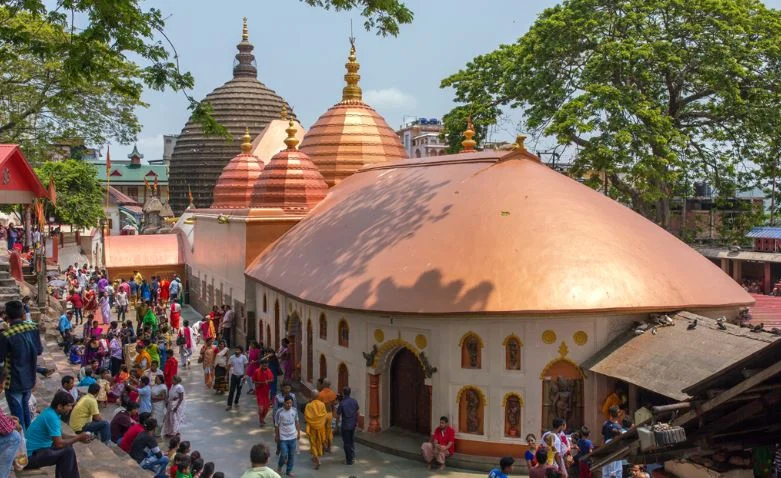
Kamakhya Temple is a popular pilgrimage destination for devotees, spiritual seekers, and tourists.
People from various parts of India and abroad visit the temple to seek blessings and experience its spiritual ambiance.
The temple’s historical and cultural significance, combined with its natural surroundings, attracts a significant number of tourists to Assam.
The tourism industry in the region has developed around the temple, offering accommodation, transportation, and other facilities to visitors.
The pilgrimage to Kamakhya Temple provides an opportunity for individuals to explore Assam’s rich cultural heritage and natural beauty.
16. Sacred Ponds and Ritual Bathing
The Kamakhya Temple complex features several sacred ponds and water bodies where devotees can take ritual baths.
These ponds, such as the Brahma Kund and other smaller tanks, are believed to have sacred and purifying properties.
Devotees consider taking a dip in these holy waters as a means of cleansing their sins and attaining spiritual purity.
The ritual bathing is often performed as a part of the worship and devotion to Goddess Kamakhya.
The sacred ponds add to the spiritual atmosphere of the temple complex and hold religious significance.
17. Cultural Facts about Kamakhya Temple
Kamakhya Temple serves as a center for promoting Assamese culture, art, and music.
The temple hosts cultural programs, traditional dance performances, and music recitals, showcasing the rich cultural heritage of Assam.
Local artists and artisans often showcase their talent and craftsmanship within the temple premises, allowing visitors to appreciate the traditional arts of the region.
The temple’s cultural significance extends beyond religious practices, contributing to the overall cultural vibrancy of Assam.
It serves as a platform for artists and performers to preserve and promote the traditional arts and culture of the state.
18. Prasadam and Offerings
Like many other Hindu temples, Kamakhya Temple offers Prasadam, which is sanctified food blessed by the goddess.
Devotees can partake in the Prasadam, which is considered auspicious and believed to carry the blessings of the goddess.
The temple also accepts offerings in the form of fruits, flowers, coconuts, and other items considered sacred in Hindu rituals.
The offerings made by devotees are received by the temple priests and distributed as Prasadam or used in the Temple rituals.
The act of offering and receiving Prasadam holds spiritual significance and symbolizes the devotee’s devotion and surrender to the divine.
19. Folklore Facts about Kamakhya Temple
Kamakhya Temple is intertwined with numerous folktales and folklore of the region.
The folklore surrounding the temple often narrates stories of miracles, divine interventions, and spiritual experiences of devotees.
These stories are passed down through generations, strengthening the faith and belief in the goddess’s powers.
Folk songs and ballads celebrating the glory of Goddess Kamakhya are an integral part of Assamese folk culture.
The temple’s folklore contributes to its cultural identity and serves as a source of inspiration and devotion for the local community.
20. Philanthropic Activities and Social Welfare
Kamakhya Temple engages in philanthropic activities and social welfare initiatives for the welfare of the community.
The temple management runs various programs and projects to provide healthcare, education, and other essential services to the underprivileged.
Donations and contributions made by devotees are often utilized for these welfare activities.
The temple’s involvement in social welfare showcases its commitment to the betterment of society and the upliftment of the less fortunate.
Through these initiatives, Kamakhya Temple aims to promote compassion, social harmony, and the values of service and empathy.
21. Tantric Pooja Practices
Kamakhya Temple is renowned for its association with tantric practices and rituals.
Tantric practitioners and spiritual seekers are drawn to the temple for its deep-rooted connection with tantra.
The temple is considered a powerful center for tantric worship and spiritual transformation.
Tantric rituals, involving mantra recitation, yantra worship, and meditation, are performed by qualified practitioners within the temple premises.
The temple’s tantric practices focus on harnessing divine energy and achieving spiritual enlightenment through disciplined practices and devotion to Goddess Kamakhya.
- Kamakhya Temple is adorned with various tantric symbols and motifs, reflecting the significance of tantra in its worship.
- The yoni-shaped stone, known as the Garvagriha or sanctum sanctorum, represents the goddess’s primordial creative energy.
- The inner sanctum is considered the holiest part of the temple and is restricted to the general public.
- The Kamakhya Temple complex also features sculptures and symbols associated with the Kundalini awakening and the chakras.
- Tantric practitioners interpret these symbols as pathways to spiritual enlightenment and inner transformation.
Related Posts
- 21 Facts About Vaishno Devi
- 19 Facts About Amarnath
- 21 Facts About Kedarnath
- 27 Facts About Badrinath
- 16 Facts About Gangotri
- 17 Facts About Yamunotri
